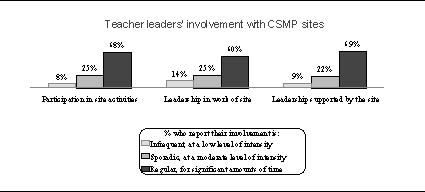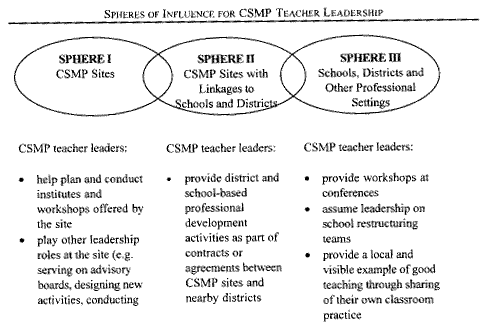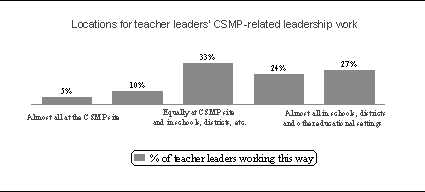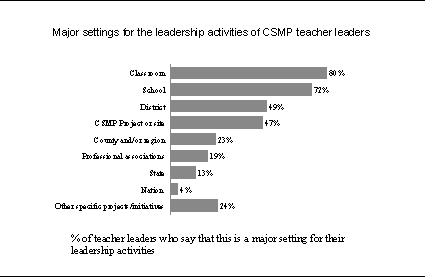|
author:
|
Inverness Research Associates
|
|
submitter:
|
Mark St. John
|
|
description:
|
This is one of three reports (Including The
Contributions of Teacher Leaders and The Work of
Teacher Leaders) wrriten by Inverness Associates
on the California Subject Matter Projects (CSMP).
"The CSMPs consist of nine Projects providing
professional development in nine different
disciplines...at 101 regional sites--all of which are
designed to attract, develop, nurture, sustain, and
promote teacher leadership."
This report examines the scale and nature of CSMP teacher leadership statewide and assesses the work of individual sites in determining the degree that they were successful in developing and deploying teacher leaders.
|
|
published in:
|
Inverness Research Associates
|
|
published:
|
1999
|
|
posted to site:
|
01/14/1999
|
NDINGS
1) Who are the CSMP teacher leaders who responded to the survey?
We received completed surveys from 1,313 CSMP teacher leaders. This sample of teacher leaders roughly represents one-half of one percent of all California’s K-12 teachers.6
Are they representative of CSMP teacher leaders overall?
The teacher leaders in this sample represent 88 sites (i.e. 91 percent) of the 97 CSMP sites operating at the time the survey was administered, and three percent of the approximately 48,000 individual teachers who participated in CSMP activities in 1994-95.7
Our sample also represents 15 percent of the estimated 8,700 teacher leaders that Site Directors report were active at their sites.8 At least 40 percent of the teacher leaders who received the survey returned it.9 We presume that they represent, on the whole, teachers who are among the most involved and committed teachers in the sites' leadership pool.
Other facts about our sample that are important to note include the following:
- While sites at all levels of development participated in the study equally, teacher leaders were slightly more likely to be associated with "mature sites" than with less developed sites. 10
- A quarter of the surveys (23 percent) were returned by Math Project-affiliated teacher leaders. Other Projects returned between six and 15 percent of the total surveys returned.
Description of the Survey Sample by Project
| |
Relative scale of the Projects |
Response rate by Project |
| PROJECT |
% of CSMP sites |
% of CSMP participants |
% of individual teachers served11 |
% of all teacher leaders in CSMP leadership pool |
% of surveys ordered12 by sites for distribution |
% of all returned surveys13 |
Arts |
10 |
3 |
3 |
6 |
12 |
11 |
| Foreign Languages |
11 |
2 |
2 |
3 |
5 |
6 |
History-Social Sciences |
10 |
8 |
8 |
6 |
11 |
12 |
| International Studies |
10 |
4 |
4 |
4 |
7 |
15 |
Math |
18 |
14 |
7 |
26 |
23 |
23 |
| Reading and Literature |
9 |
9 |
9 |
26 |
7 |
7 |
Science |
13 |
19 |
8 |
10 |
20 |
13 |
| Writing |
18 |
41 |
62 |
19 |
15 |
14 |
In summary it appears that some subgroups of teacher leaders tended to respond to the survey more than others.
What are the characteristics of the CSMP teacher leaders?
The following characteristics of the CSMP teacher leadership group emerge from the survey data:
- CSMP teacher leaders are representative of California teachers in terms of their ethnic diversity (79 percent white vs. 80 percent for all California K-12 public school teachers14). They are, however, slightly less diverse than CSMP institute participants.
Ethnicity of CSMP Teacher Leaders Compared to
CSMP Participants, Site Leaders, and All California Teachers
| |
CSMP Teacher Leaders |
CSMP Institute Participants |
CSMP Site Leaders |
All California Teachers |
| African American |
4% |
5% |
6% |
5% |
| Asian |
4 |
4 |
5 |
4 |
| Hispanic; Latino/a |
9 |
12 |
10 |
9 |
| Native Alaskan/Am. Indian |
1 |
1 |
1 |
1 |
| Pacific Islander |
1 |
1 |
1 |
1 |
| White |
79 |
73 |
77 |
80 |
| Other |
2 |
4 |
1 |
0 |
Data sources: 1994 - 95 annual site survey for data on institute participants and site leaders (i.e. principal investigators, project directors, co-directors, assistant directors, etc.). 1994 - 95 California Basic Educational Data system (CBED) data are used throughout the report for overall California figures.
- Women are somewhat over-represented among CSMP teacher leaders (81 percent vs. 71 percent for California teachers overall).
- A third are under 40 years old, a third are between 40 and 50, and a third over 50.
- CSMP teacher leaders bring considerable teaching experience to the Projects. The average teacher leader has been teaching 17 years and has 14 years experience teaching the discipline in which she or he "specializes."
- Nearly four out of ten (39 percent) of our survey respondents say their discipline specialty lies in math or the language arts. The rest say they specialize in other areas or consider themselves generalists.
Disciplines in Which Teacher Leaders Specialize
| |
Primary discipline |
Language arts |
23% |
| Mathematics |
16 |
History/Social sciences |
13 |
| Science |
10 |
Arts and/or Music |
9 |
| Foreign language |
6 |
Other specified specialty |
9 |
| "Generalist" |
14 |
If we look at grade levels taught by these teacher leaders, it appears that they represent the grades proportionately.
Grade Levels
| |
CSMP Teacher Leaders |
All California Teachers |
| K - 2 |
9% |
59% |
| 3 - 5 |
17 |
(total for |
| 6 - 8 |
26 |
K - 8) |
| 9 - 12 |
25 |
20 |
| Other15 |
23 |
20 |
Which schools are represented by the CSMP teacher leaders?
At least 82 percent (1,076) of the sample of teacher leaders returning the survey currently teach in public schools at the K - 12 level; the rest teach in private schools, at the community college level, or did not indicate where they are teaching.
- The teachers included in this sample work in 850 different schools, and therefore represent 11 percent of all California public schools at the K-12 level, 36 percent of the state’s school districts, and 93 percent of California counties.
- The schools they teach in are roughly representative of California schools in terms of community location, having a slightly greater concentration in suburban settings.
School Location16
| |
California schools |
Responding teacher leaders |
Urban |
31% |
31% |
| Suburban |
42 |
47 |
Rural |
27 |
22 |
Are the students of these teacher leaders representative of California’s student population?
We estimate that up to two percent of California’s students are taught at least one period a day by these 1,313 teacher leaders.17 The degree to which these students are fully representative of the state’s student population is not entirely clear, due to inconsistent information provided by the teacher leaders.
- Their students may be disproportionately white. While 59 percent of all California students and 57 percent of the students at schools represented by teacher leaders are of color, only 41 percent of the students they personally teach are of color. We speculate that teachers may not be estimating accurately, but the difference raises the question of whether a high percentage of teacher leaders are teaching "high track" classes.
- Their students reflect the California student body overall in terms of inclusion of non-native speakers of English and Title I students.
- At the same time, the teacher leaders report that their classes include a disproportionately high percentage of students who receive AFDC.
Characteristics of Students Taught by Teacher Leaders
| |
All California students
(CBED/CDE* data) |
Students at schools represented by teacher leaders (CBED data) |
Students taught by responding teacher leaders18 |
| Students of color |
59% |
57% |
41% |
| English language learners (LEP/NEP students) |
23% |
Not available |
23% |
| AFDC students |
21% |
Not available |
40% |
| Title I students |
28% |
Not available |
33% |
* California Department of Education
In short, the CBED figures and teacher leader self-report data do not combine to create as clear picture of these teachers’ students as we would like.
2) What is the nature and extent of teacher leaders' involvement with the Projects and sites?
A notable and important finding from the survey is that CSMP sites tend to maintain a steady, ongoing relationship with their teacher leaders.
- The average teacher leader has been involved with the site that sent them a survey for five years, and has played a leadership role for four years.
- Two-thirds of these teacher leaders have been involved with their site regularly and for a significant amount of time since they first became involved with it.
- Two-thirds were involved for significant amounts of time as participants and leaders over the previous 12 months.

There is also considerable movement between Project sites by active teacher leaders.
- Almost half (45 percent) of the teacher leaders have attended institutes or other activities at other sites of the same Project that sent the survey to them, and over a quarter (28 percent) have played a leadership role for another site of their Project.
- Over a third (37 percent) of the teacher leaders have attended activities at another Project and one in five (20 percent) has played a leadership role for another Project.
- Thirty-five percent of those who reported involvement with another Project named the Writing Project.19 This is twice as many as attended activities at the next most frequently named Projects — Reading and Literature (17 percent) and Math (15 percent). Fewer "crossed over" to the Science (12 percent), History and Social Sciences (10 percent), International Studies (5 percent), or Foreign Languages (1 percent) Projects.
3) Where do teacher leaders carry out their leadership work?
The survey results show that teachers leaders are active in each leadership sphere. In particular, much of the work that teacher leaders do occurs in the third sphere for teacher leadership — in schools and other professional arenas where their leadership activities have no formal relationship to the CSMPs.
Spheres of Influence for CSMP Teacher Leadership

In fact, it is probable that most of the leadership activities of the CSMP teacher leaders take place in settings other than the institutes and workshops of the CSMPs.20 Most of the leadership provided by teacher leaders, then, has the potential to benefit students and other teachers who are not CSMP participants themselves.
- Half the teachers (51 percent) say that most of their CSMP-related leadership roles have been in schools, districts, and other educational settings outside their CSMP site.
- A third (33 percent) play CSMP-related leadership roles about equally at the site and in schools.
- Fifteen percent find most of their leadership opportunities at their CSMP site.

Much of their leadership draws upon their own classroom expertise and takes place in schools.

Percentages represent teachers who selected 4 or 5 on a 5-point scale where 1 = "Not a part of my leadership activities" and 5 = "A major part of my leadership activities."
|

